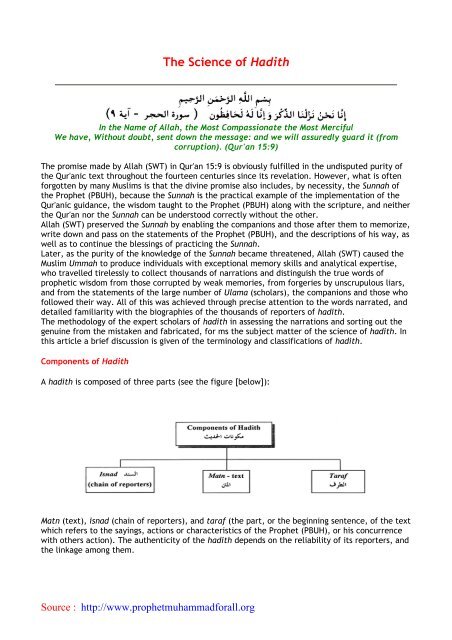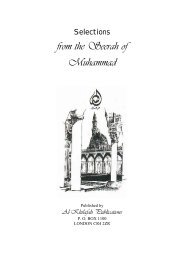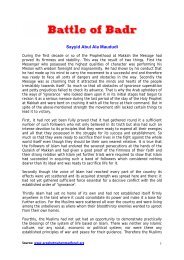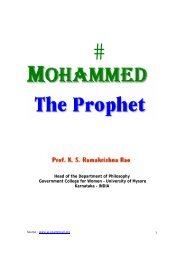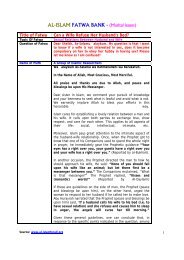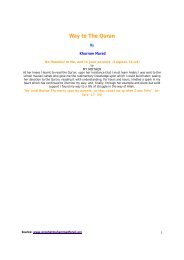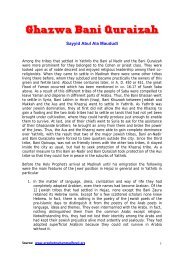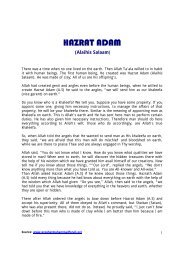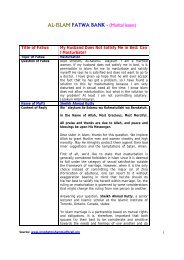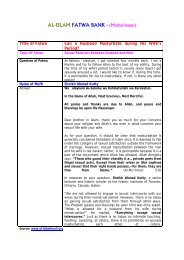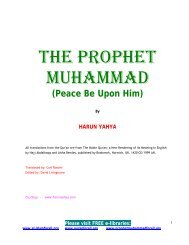The Science of Hadith - Prophet Muhammad (SAW) for All
The Science of Hadith - Prophet Muhammad (SAW) for All
The Science of Hadith - Prophet Muhammad (SAW) for All
Create successful ePaper yourself
Turn your PDF publications into a flip-book with our unique Google optimized e-Paper software.
<strong>The</strong> <strong>Science</strong> <strong>of</strong> <strong>Hadith</strong><br />
In the Name <strong>of</strong> <strong>All</strong>ah, the Most Compassionate the Most Merciful<br />
We have, Without doubt, sent down the message: and we will assuredly guard it (from<br />
corruption). (Qur'an 15:9)<br />
<strong>The</strong> promise made by <strong>All</strong>ah (SWT) in Qur'an 15:9 is obviously fulfilled in the undisputed purity <strong>of</strong><br />
the Qur'anic text throughout the fourteen centuries since its revelation. However, what is <strong>of</strong>ten<br />
<strong>for</strong>gotten by many Muslims is that the divine promise also includes, by necessity, the Sunnah <strong>of</strong><br />
the <strong>Prophet</strong> (PBUH), because the Sunnah is the practical example <strong>of</strong> the implementation <strong>of</strong> the<br />
Qur'anic guidance, the wisdom taught to the <strong>Prophet</strong> (PBUH) along with the scripture, and neither<br />
the Qur'an nor the Sunnah can be understood correctly without the other.<br />
<strong>All</strong>ah (SWT) preserved the Sunnah by enabling the companions and those after them to memorize,<br />
write down and pass on the statements <strong>of</strong> the <strong>Prophet</strong> (PBUH), and the descriptions <strong>of</strong> his way, as<br />
well as to continue the blessings <strong>of</strong> practicing the Sunnah.<br />
Later, as the purity <strong>of</strong> the knowledge <strong>of</strong> the Sunnah became threatened, <strong>All</strong>ah (SWT) caused the<br />
Muslim Ummah to produce individuals with exceptional memory skills and analytical expertise,<br />
who travelled tirelessly to collect thousands <strong>of</strong> narrations and distinguish the true words <strong>of</strong><br />
prophetic wisdom from those corrupted by weak memories, from <strong>for</strong>geries by unscrupulous liars,<br />
and from the statements <strong>of</strong> the large number <strong>of</strong> Ulama (scholars), the companions and those who<br />
followed their way. <strong>All</strong> <strong>of</strong> this was achieved through precise attention to the words narrated, and<br />
detailed familiarity with the biographies <strong>of</strong> the thousands <strong>of</strong> reporters <strong>of</strong> hadith.<br />
<strong>The</strong> methodology <strong>of</strong> the expert scholars <strong>of</strong> hadith in assessing the narrations and sorting out the<br />
genuine from the mistaken and fabricated, <strong>for</strong> ms the subject matter <strong>of</strong> the science <strong>of</strong> hadith. In<br />
this article a brief discussion is given <strong>of</strong> the terminology and classifications <strong>of</strong> hadith.<br />
Components <strong>of</strong> <strong>Hadith</strong><br />
A hadith is composed <strong>of</strong> three parts (see the figure [below]):<br />
Matn (text), isnad (chain <strong>of</strong> reporters), and taraf (the part, or the beginning sentence, <strong>of</strong> the text<br />
which refers to the sayings, actions or characteristics <strong>of</strong> the <strong>Prophet</strong> (PBUH), or his concurrence<br />
with others action). <strong>The</strong> authenticity <strong>of</strong> the hadith depends on the reliability <strong>of</strong> its reporters, and<br />
the linkage among them.<br />
Source : http://www.prophetmuhammad<strong>for</strong>all.org
Classifications <strong>of</strong> <strong>Hadith</strong><br />
A number <strong>of</strong> classifications <strong>of</strong> hadith have been made. Five <strong>of</strong> these classifications are shown in<br />
the figure [below], and are briefly described subsequently.<br />
Source : http://www.prophetmuhammad<strong>for</strong>all.org
1. According to the reference to a particular authority<br />
2.<br />
Four types <strong>of</strong> hadith can be identified.<br />
o Qudsi - Divine; a revelation from <strong>All</strong>ah (SWT); relayed with the words <strong>of</strong> the<br />
<strong>Prophet</strong> (PBUH).<br />
o Marfu - elevated; a narration from the <strong>Prophet</strong> (PBUH), e.g. I heard the <strong>Prophet</strong><br />
(PBUH) saying ...<br />
o Mauquf- stopped: a narration from a companion only, e.g., we were commanded to<br />
...<br />
o Maqtu' - severed: a narration from a successor.<br />
Source : http://www.prophetmuhammad<strong>for</strong>all.org
3. According to the links <strong>of</strong> Isnad - interrupted or uninterrupted<br />
Six categories can be identified.<br />
o Musnad - supported: a hadith which is reported by a traditionalist, based on what<br />
he learned from his teacher at a time <strong>of</strong> life suitable <strong>for</strong> learning; similarly - in turn<br />
- <strong>for</strong> each teacher until the isnad reaches a well known companion, who in turn,<br />
reports from the <strong>Prophet</strong> (PBUH).<br />
o Mutassil - continuous: a hadith with an uninterrupted isnad which goes back only to<br />
a companion or successor.<br />
o Mursal - hurried: if the link between the successor and the <strong>Prophet</strong> (PBUH) is<br />
missing, e.g. when a successor says "<strong>The</strong> <strong>Prophet</strong> said...".<br />
o Munqati - broken: is a hadith whose link anywhere be<strong>for</strong>e the successor (i.e.,<br />
closer to the traditionalist recording the hadith) is missing.<br />
o Mu'adal - perplexing: is a hadith whose reporter omits two or more consecutive<br />
reporters in the isnad.<br />
o Mu'allaq - hanging: is a hadith whose reporter omits the whole isnad and quotes<br />
the <strong>Prophet</strong> (PBUH) directly (i.e., the link is missing at the beginning).<br />
4. According to the number <strong>of</strong> reporters involved in each stage <strong>of</strong> Isnad<br />
Five categories <strong>of</strong> hadith can be identified:<br />
o Mutawatir - Consecutive: is a hadith which is reported by such a large number <strong>of</strong><br />
people that they cannot be expected to agree upon a lie, all <strong>of</strong> them together.<br />
o Ahad - isolated: is a hadith which is narrated by people whose number does not<br />
reach that <strong>of</strong> the mutawatir.<br />
It is further classified into:<br />
o Mash'hur - famous: hadith reported by more than two reporters.<br />
o Aziz - rare, strong: at any stage in the isnad, only two reporters are found to<br />
narrate the hadith.<br />
o Gharib - strange: At some stage <strong>of</strong> the Isnad, only one reporter is found relating it.<br />
5. According to the nature <strong>of</strong> the text and isnad<br />
o Munkar - denounced: is a hadith which is reported by a weak narrator, and whose<br />
narration goes against another authentic hadith.<br />
o Mudraj - interpolated: an addition by a reporter to the text <strong>of</strong> the hadith being<br />
narrated.<br />
6. According to the reliability and memory <strong>of</strong> the reporters<br />
This provides the final verdict on a hadith - four categories can be identified:<br />
o Sahih - sound. Imam Al-shafi'i states the following requiremetts <strong>for</strong> a hadith, which<br />
is not mutawatir, to be acceptable "each reporter should be trustworthy in his<br />
religion; he should be known to be truthtul in his narrating, to understand what he<br />
narrates, to know how a different expression can alter the meaning, and to report<br />
the wording <strong>of</strong> the hadith verbatim, not only its meaning".<br />
o Hasan - good: is the one where its source is known and its reporters are<br />
unambiguous.<br />
o Da'if - weak: a hadith which fails to reach the status <strong>of</strong> hasan. Usually, the<br />
weakness is: a) one <strong>of</strong> discontinuity in the isnad, in which case the hadith could be<br />
- according to the nature <strong>of</strong> the discontinuity - munqati (broken), mu'allaq<br />
(hanging), mu'dal (perplexing), or mursal (hurried), or b) one <strong>of</strong> the reporters<br />
having a disparaged character, such as due to his telling lies, excessive mistakes,<br />
opposition to the narration <strong>of</strong> more reliable sources, involvement in innovation, or<br />
ambiguity surrounding his person.<br />
o Maudu' - fabricated or <strong>for</strong>ged: is a hadith whose text goes against the established<br />
norms <strong>of</strong> the <strong>Prophet</strong>'s sayings, or its reporters include a liar. Fabricated hadith are<br />
also recognized by external evidence related to a discrepancy found in the dates or<br />
times <strong>of</strong> a particular incident.<br />
Source :<br />
http://www.prophetmuhammad<strong>for</strong>all.org


